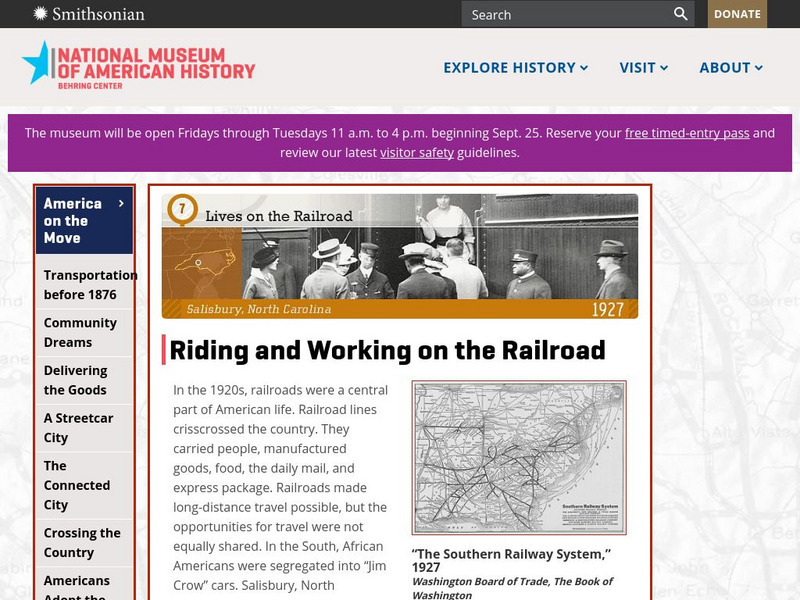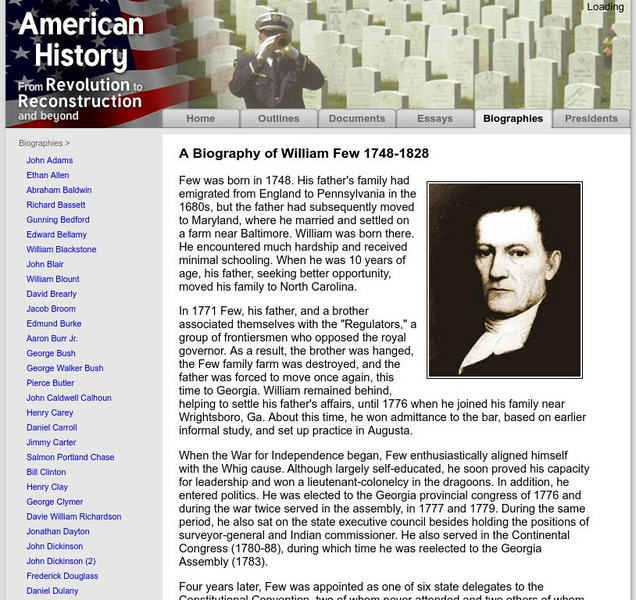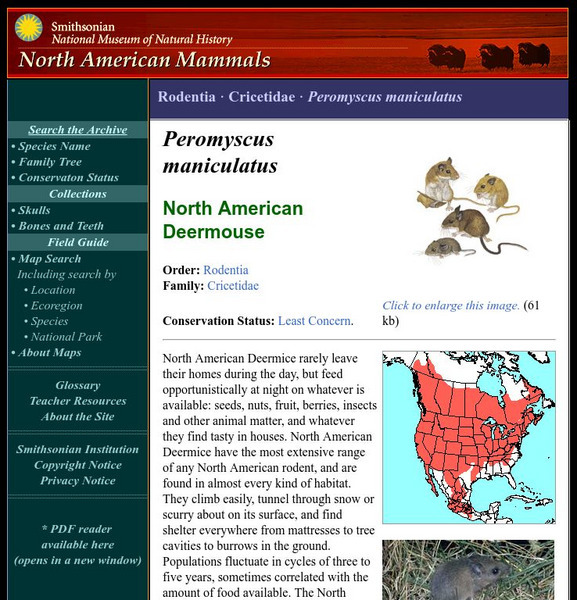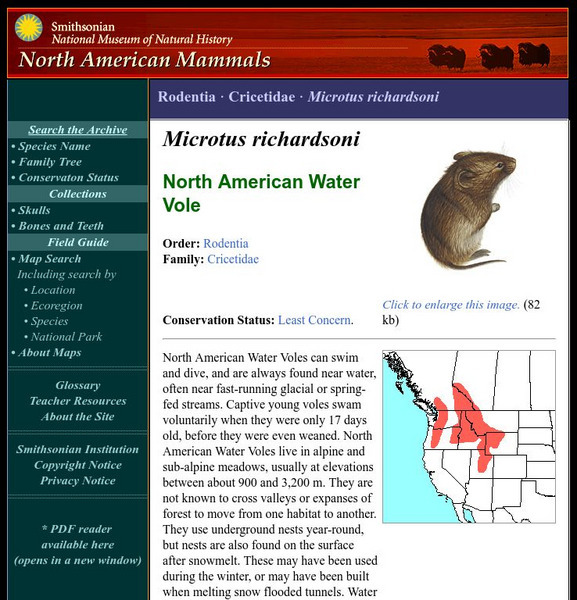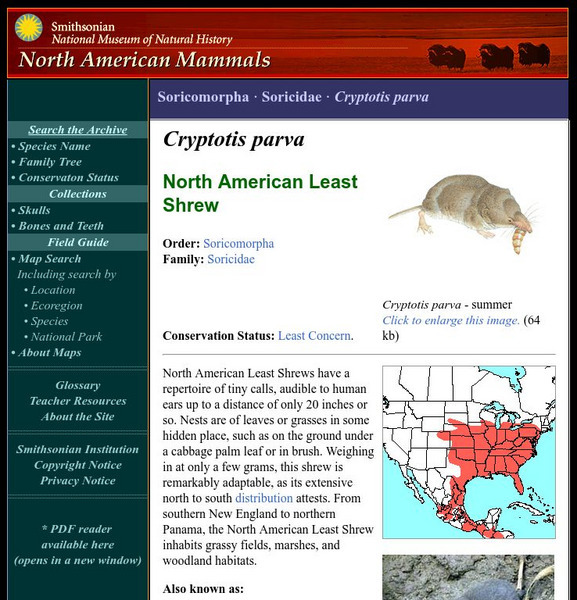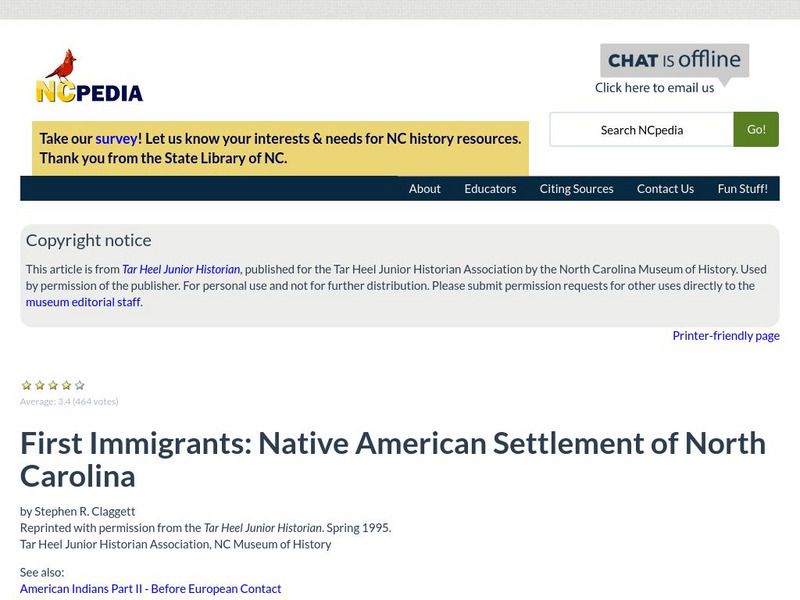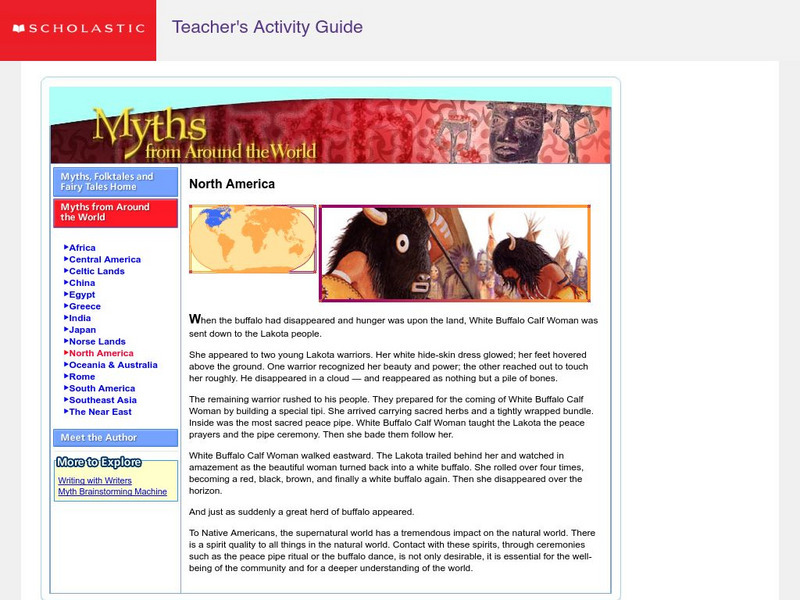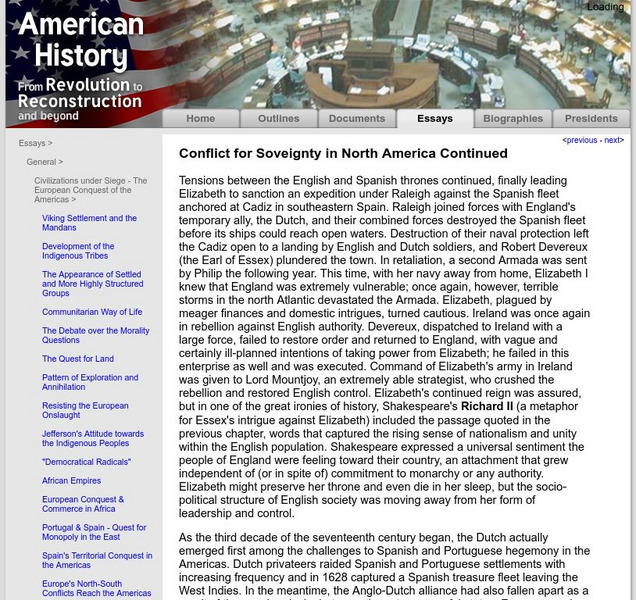Hi, what do you want to do?
Smithsonian Institution
National Museum of American History: Lives on the Railroad: Salisbury, North Carolina 1927
Replica of the Salisbury, North Carolina railway station teaches about riding and working on the railroad in the 1920s when railroads were a central part of American life. Railroad lines crisscrossed the country. They carried people,...
World Atlas
World Atlas: North America
Features maps and a description of the geography and history of North America with links to information on its countries, famous people, flags, symbols, and much more.
University of Groningen
American History: Biographies: William Blount 1749 1800
William Blount was the great-grandson of Thomas Blount, who came from England to Virginia soon after 1660 and settled on a North Carolina plantation. William, the eldest in a large family, was born in 1749 while his mother was visiting...
University of Groningen
American History: Biographies: William Richardson Davie 1756 1820
One of the eight delegates born outside of the thirteen colonies, Davie was born in Egremont, Cumberlandshire, England, on June 20, 1756. In 1763 Archibald Davie brought his son William to Waxhaw, SC, where the boy's maternal uncle,...
University of Groningen
American History: Biographies: Richard Dobbs Spaight, Sr. 1758 1802
Spaight was born at New Bern, NC of distinquished English-Irish parentage in 1758. When he was orphaned at 8 years of age, his guardians sent him to Ireland, where he obtained an excellent education. He apparently graduated from...
University of Groningen
American History: Biographies: Henry Carey 1793 1879
Henry Carey was the eldest son of Mathew Carey, an Irish freedom fighter who was recruited to the intelligence networks established by Benjamin Franklin, and sent to Philadelphia to run what was then the largest printing operation in...
University of Groningen
American History: Biographies: George Read 1733 1798
Read's mother was the daughter of a Welsh planter, and his Dublin-born father a landholder of means. Soon after George's birth in 1733 near the village of North East in Cecil County, MD, his family moved to New Castle, DE, where the...
University of Groningen
American History: Biographies: William Few 1748 1828
Few was born in 1748. His father's family had emigrated from England to Pennsylvania in the 1680s, but the father had subsequently moved to Maryland, where he married and settled on a farm near Baltimore. William was born there. He...
Smithsonian Institution
National Museum of American History: Jamestown, Quebec, Santa Fe: Three North American Beginnings
Explore the origins of Canada and the United States as Jamestown, Quebec, and Santa Fe celebrate their 400th anniversary.
Khan Academy
Khan Academy: Us History: 1800 1848: The War of 1812
The War of 1812 pitted US forces against those of Great Britain in a battle for control over the destiny of the North American continent.
Other
University of Exeter: History of Money From Ancient Times to the Present Day
A collection of fairly in-depth essays using information from a book on the history of money. Some titles include "The History of Celtic Coinage," "Money in North American History," and "Britain and European Monetary Union."
Smithsonian Institution
National Museum of Natural History: American Mammals: North American Deermouse
North American Deermice rarely leave their homes during the day, but feed opportunistically at night on whatever is available: seeds, nuts, fruit, berries, insects and other animal matter, and whatever they find tasty in houses. Deermice...
Smithsonian Institution
National Museum of Natural History: American Mammals: North American Water Vole
North American Water Voles can swim and dive, and are always found near water, often near fast-running glacial or spring-fed streams. Captive young Voles swam voluntarily when they were only 17 days old, before they were even weaned....
Smithsonian Institution
National Museum of Natural History: American Mammals: North American Porcupine
North American Porcupines are large, slow-moving, tree-climbing rodents, protected from predators by their formidable quills. In winter, they eat the bark, phloem, and cambium of trees, particularly conifers. Learn more about the...
Smithsonian Institution
National Museum of Natural History: American Mammals: North American Least Shrew
North American Least Shrews have a repertoire of tiny calls, audible to human ears up to a distance of only 20 inches or so. Nests are of leaves or grasses in some hidden place, such as on the ground under a cabbage palm leaf or in...
Smithsonian Institution
National Museum of Natural History: North American Mammals
This concise site contains photos of North American mammals along with a map showing where they currently can be found. Includes links to other mammal sites.
A&E Television
History.com: The States
Learn unique facts about each American state. You can also read a more in-depth history of each state, watch videos and play a game about all the states.
Smithsonian Institution
National Museum of Natural History: Red Wolf
The Smithsonian National Museum of Natural History, in a section titled "North American Mammals," offers a general overview of the red wolf. Content includes a focus on this animal's conservation status, habitat and range, and other key...
State Library of North Carolina
N Cpedia: Stephen R. Claggett: Native American Settlement of North Carolina
The English began exploring and settling into the Carolina Colony in the late 1500-early 1600s. The land was already inhabited by Native American tribes. How did they all get along? Who were the Native Americans on the land?
State Library of North Carolina
N Cpedia: John W. Kinchelo, Iii: American Indians at European Contact
Native Americans inhabited the New World long before European explorers began establishing settlements on the land. This entry addresses the challenges the natives had to face upon Europe's arrival, trials in relationships, and how...
Scholastic
Scholastic: Myths From Around the World: North America
Learn about the North American White Buffalo Calf Woman through this ancient myth. Discover how the Calf Woman went to the Lakota people and how the spirit quality is essential to the North American light.
University of Groningen
American History: Outlines: The War in North Africa and Europe
Overview of the course of World War II in North Africa and Europe.
University of Groningen
American History: Outlines: The First Americans
Brief overview on the history and theory of migration of the first inhabitants of North America. Links to Wikipedia for definitions are embedded in the text.
University of Groningen
American History: Essays: Conflict for Sovereignty in N. Amer. Continued
Essay outlines the continued tension between England, Spain and other European nations in their quest for power. The British claim sovereignty over North America.





